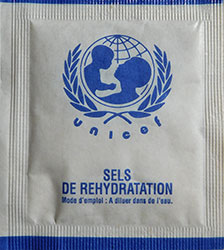Encouraging research innovations that improve health
September / October 2018 | Volume 17, Number 5
Opinion by Fogarty Director Dr Roger I Glass
I find anniversaries can provide us with useful opportunities for reflection. As a diarrheal disease expert, I have recently been contemplating the impact of a research breakthrough that occurred fifty years ago - the discovery that oral rehydration therapy (ORT) could save thousands of people at risk of dying of cholera, for a treatment that cost just pennies to administer.
In 1968, a report from Bangladesh was published that described how oral rehydration solution (ORS) was used to successfully treat patients hospitalized in shock with cholera gravis, which untreated had a 40 percent mortality rate. Although research in the 1940s had demonstrated that administration of intravenous (IV) fluids was an effective approach, many cholera sufferers were located in low-resource settings where that was not available. For them, ORS was a miracle!
A few years later, at a cost of five cents each, UNICEF began producing and distributing packets of ORS that were to be added to a liter of water. Since 1968, the estimated number of childhood deaths from diarrhea has declined from about 5 million per year to about half a million.
In 1992, following years of debate about use of ORT in the U.S., the CDC recommended ORT should be the treatment of choice for all American children with diarrhea.
So what can we learn from this story of discovery that we could apply to other deadly diseases?

By Cjp24 via Creative Commons
CC BY-SA 4.0
Packets of oral rehydration
solution (ORS) produced by
UNICEF offer an affordable
treatment for cholera patients.
Sometimes the solutions are simple
Previous research had shown that sugar and salt mixed with water helped cholera patients. But it also killed some of them. The young scientists working in Bangladesh decided to measure the patients’ output and use that as a basis to decide how much fluid to replace. That was the key to success.
Persistence in the face of failure
As I’ve learned in my rotavirus vaccine development career, setbacks are inevitable. By studying what went wrong, seeking advice from others and redoubling my efforts, I have managed to help produce some effective tools that prevent child deaths.
Necessity is the mother of invention
An American team of young physician-scientists found themselves in the unique setting of endemic cholera in the Ganges delta. People would literally die in front of them if the researchers didn’t find an affordable, yet effective treatment. This wasn’t a discovery made in a remote lab, it was made on the front lines of human suffering.
Optimism and fresh perspectives of youth
Established diarrheal disease experts knew ORS could be the answer but were perhaps intimidated by earlier failed clinical trials that resulted in some deaths.
Success breeds success
The 1968 article detailing the positive results was followed by a burst of research that increased the use of ORT for other diarrheal diseases and advanced new formulations that included zinc and encouraged feeding during diarrhea.
Oral rehydration therapy remains the mainstay of treatment for diarrhea worldwide - including in the U.S. - for both adults and children and can be used by parents at home, as well as in clinics and hospitals.
Perhaps there are other simple treatments awaiting discovery that could prevent childhood deaths from other causes. I hope this story of success helps motivate some of today’s young scientists. With the lives of so many children at stake, what better motivation can any of us have?
More Information
To view Adobe PDF files,
download current, free accessible plug-ins from Adobe's website.